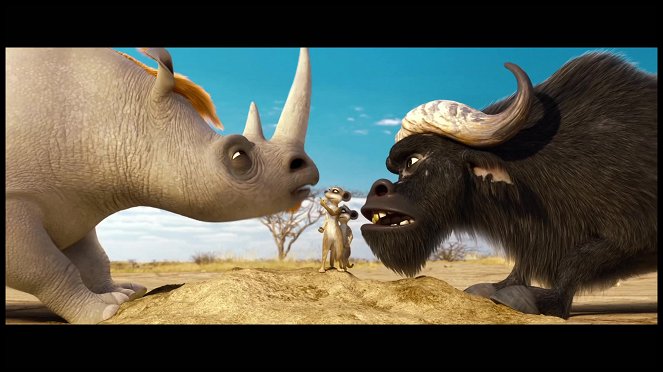Sävellys:
David NewmanNäyttelijät:
Oliver Kalkofe, Bastian Pastewka, Christoph Maria Herbst, Constantin von Jascheroff, Thomas Fritsch, Santiago Ziesmer, Ralf Schmitz, Uli Krohm (lisää)Suoratoistopalvelut (2)
Juonikuvaukset(1)
Eräänä päivänä afrikkalaisen savannin eläimet alkavat ihmetellä, mitä vedelle on tapahtunut. Sen olisi pitänyt jo aikoja sitten virrata vuolaana kaukaisilta vuorilta heidän omaan laaksoonsa. Kasvava jano alkaa huolestuttaa savannin jengiä, varsinkin kun viimeisestäkin juomapaikasta taistelevat kiukkuiset puhvelit ja sarvikuonot. Niinpä urhea mangusti Billy ja hänen paras kaverinsa, lokoisa leijona Socrates, lähtevät etsimään vettä. Billy tahtoo todistaa pojalleen olevansa paljon muutakin kuin se hermoheikko vauhtiveikko, jona kaikki hänet tuntevat, ja että poika voi hyvällä syyllä olla ylpeä isästään. Matkalla kaksikko tapaa gallialaisen kukon nimeltä Charles, jolla on johdettavanaan todellinen omituisten otusten kerho: jääkarhutyttö, kenguru, tasmanialainen pussiahma ja kaksi galápagoksen-jättiläiskilpikonnaa. Niiden kaukaiset kotiseudut ovat tuhoutuneet, joten ne ovat joutuneet etsimään parempaa tulevaisuutta Okavangon suistosta. Tietysti myös ihmiset ovat tunkeutuneet tähän viimeiseen paratiisiin: liikemies Smith on rakennuttanut valtavan padon johtaakseen vettä luksuslomakeskukseensa, jonne sattumalta ovat samaan aikaan kokoontuneet maailman poliitikot pohtimaan sitä, miten ympäristö voitaisiin pelastaa. Eläimet vastaavat huutoon järjes tämällä ikioman konferenssinsa: viisas norsuemo Angie kutsuu mukaan kaikki eläimet pienistä suuriin – ja niin luonnossa kiirii todellinen erämaan kutsu, kun savannijengi käy yhteistuumin vastarintaan. Ja sehän lupaa vauhdikasta toimintaa, hilpeää seikkailua ja eläimellisen hauskoja kujeita. (SF Film Fin.)
(lisää)Arvostelut (1)
Currently, it is completely normal for an animated film to carry an ecological message. Do not do this because you are hurting animals. Children are thus exposed to the idea from a young age that they should behave nicely towards nature, let animals live, and definitely not pollute the environment in any way. "Happy Feet 2" showed the threat of global warming, but it didn't realize that kids probably wouldn't care about that, and adults would ignore such a film. "The Lorax" was more successful and tells children that we should not destroy anything that nature has given us. Out of the three films I will mention in this paragraph, it is definitely the best. Next up is "Hooray for Africa!", a film so heavily focused on ecology that it's glaringly obvious. The poor animals in Africa are in a terrible situation because people have built a dam that holds all the water in one place. The reason? Simple. An amusement resort was built on the dam, which will make a lot of money. Animals can suffer in the meantime. The film boldly states sentences that condemn such human behavior, and the animals are shown as a group that can unite for a greater purpose. The film is incredibly unrealistic and heart-wrenching, trying to play on the cute factor, which is the only way to get children on its side, so that they take away the final message that a person can be happy without money, especially when there are happy animals around. I don't want to diminish the efforts of environmentalists to do something about how we treat the world, but this is simply a bad attempt. Even the animation, which cannot compare to American animation, wouldn't be a problem if it weren't for the story, which is incredibly simplistic. The holding of water in the comic "Habibi" had a much greater impact on me, which is definitely not an ecological work, and certainly not a flawless comic. "Hooray for Africa!" is another attempt to differentiate European animation from American animation. It is an unsuccessful, weak, and humorless attempt. More: http://www.filmovy-denik.cz/2012/08/jane-eyre-ekologicka-afrika-cislo.html
()

